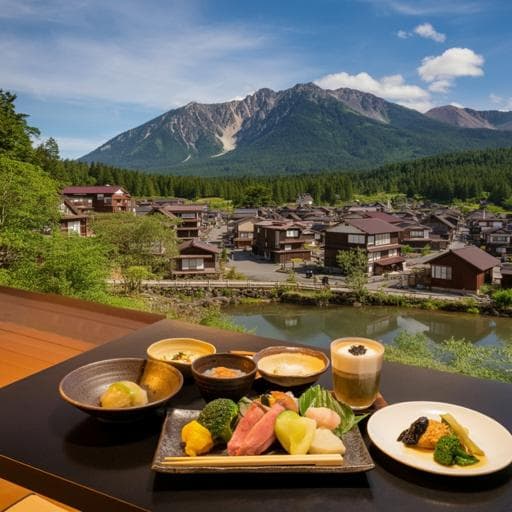
Tourism
Sustainable rural development in Northwest Iran: proposing a wellness-based tourism pattern using a structural equation modeling approach
H. Esfandyari, S. Choobchian, et al.
This research by Hossein Esfandyari, Shahla Choobchian, Yadgar Momenpour, and Hossein Azadi delves into the factors driving wellness tourism in Sarab County, Iran, highlighting the influence of location, climate, and cultural appeals, all while navigating the challenges presented by the COVID-19 pandemic.
~3 min • Beginner • English
Introduction
The study situates wellness tourism within the broader challenges of rapid industrialization, technological change, and urbanization that affect societal well-being. Drawing on WHO’s holistic definition of health, the authors distinguish wellness tourism from medical and therapeutic tourism and highlight wellness tourism’s emphasis on pristine environments, nature, healthy food, exercise, and relaxation. The COVID-19 pandemic severely disrupted tourism globally and in Iran, intensifying psychological stress and economic hardship, while positioning rural, less-crowded destinations as viable, safer alternatives. East Azerbaijan province, notably Sarab County, has significant natural and hydrotherapy resources suitable for wellness tourism. The study’s purpose is to identify and prioritize the determinants of wellness tourism destination choice and to model wellness-related dimensions (physical, social, individual) and external destination factors (place, quality and facilities, marketing and price, satisfaction) using structural equation modeling (SEM) in Northwest Iran. Research questions: (1) What are the most important aspects of wellness-based tourism after the pandemic? (2) What are the most prominent determinants influencing wellness tourism dimensions after the pandemic?
Literature Review
The literature differentiates health, medical, therapeutic, and wellness tourism, noting overlaps while emphasizing wellness tourism’s focus on enhancing physical, psychological, spiritual, and social well-being without medical intervention. Prior studies explored determinants like environmental and economic conditions, policy uncertainty, and nature-based tourism; benefits such as improved QoL and happiness; and conceptual models highlighting PERMA, emotions, and participation. However, gaps remain: insufficient attention to physical and individual dimensions, lack of integrated consideration of satisfaction and external destination factors, and few models tailored to rural wellness destinations. The authors develop a conceptual framework comprising three wellness dimensions (physical, social, individual) and four external destination factors (place; quality and facilities; tourism satisfaction; marketing and price), addressing neglected constructs such as satisfaction.
Methodology
Design: Quantitative, positivist, non-experimental, cross-sectional survey with descriptive and causal-relational analyses; field study context. Study area: Sarab County, East Azerbaijan province, Iran—rich in hot/mineral springs, mountainous climate, cultural-historical sites, and agricultural products, yet facing rural depopulation and rising unemployment. Population and sample: 237,415 tourists visiting Sarab’s natural attractions (2018–2019). Sample size: 384 (Krejcie & Morgan). Data collection: January–May 2021 via structured face-to-face questionnaires; multi-stage random sampling using mapping/lister teams to enumerate accommodation units and systematically sample eligible wellness tourists; informed consent secured. Measures: Dependent variable ‘Wellness-based tourism (WBT)’ operationalized via three latent dimensions—physical (4 items: physical activity; fresh/healthy/local food; feeling refreshed; pain relief), social (5 items: supportive relationships; attachment to compatriots; time with family/friends; visiting locals; meeting new people), and individual (10 items: inner peace and stress relief; skill development; self-awareness; new experiences/ideas/information; pleasant experiences; avoiding routine; freedom; relaxation). Independent variables: satisfaction (12 items), place (7 items), marketing and price (4 items), quality and facilities (14 items). Likert 1–5 (very low to very high). Reliability and validity: Expert validation by Iranian Health Tourism Association; pilot Cronbach’s alpha ≥0.70 for all constructs; CR >0.60; AVE ≥0.50 indicating convergent validity. Common method bias checks: procedural remedies; Harman’s single-factor (first factor 16.92% <50%); one-factor CFA poor fit (χ²=93.443; NFI=0.886; RMSEA=0.117; PNFI=0.633; CMIN/DF=6.230); single-factor AVE=0.345; common latent factor test showed standardized weight differences <0.20, indicating CMB not a threat. Analysis: SEM using AMOS; assessment of measurement and structural models; fit indices (CFI, GFI, NFI, TLI, RMSEA); estimation primarily via maximum likelihood; examination of path coefficients from external factors (place; quality and facilities; marketing and price; satisfaction) to wellness; wellness measured by physical, social, individual dimensions.
Key Findings
Sample profile (n=384): 65.6% male; 65.9% married; 45.8% full-time employed. Mean age ≈35.5 years; 54.68% <35 years; 33.07% had 12<X≤18 years schooling; 63.28% annual income <$1,500. Wellness dimensions: physical mean 4.14; individual 3.63; social 3.57; Friedman test significant (p<0.001), physical highest. Top items: physical—feeling refreshed and relief from physical fatigue/pain; individual—resting/relaxation, inner peace/stress relief; social—supportive relationships, time with family/friends. External factors (current condition means): satisfaction 3.13 (rank 1), place 2.92 (rank 2), marketing & price 2.53 (rank 3), quality & facilities 2.41 (rank 4); Friedman p<0.01. Highest satisfaction items: environmental safety and cleanliness; lowest included access to buses/taxis. Correlations with wellness (all p<0.001): place r=0.675; marketing & price r=0.535; satisfaction r=0.508; quality & facilities r=0.413. Discriminant validity supported. SEM fit: CMIN/DF=2.172; CFI=0.987; GFI=0.981; NFI=0.986; TLI=0.981; RMSEA=0.05. Explained variance: wellness R²=0.62 by four external latent variables. Overall effects on wellness: place 0.825 (largest), satisfaction 0.579, marketing & price 0.545, quality & facilities 0.391. Reported regression form: Wellness = 28.21 + 1.113*Place + 0.281*Satisfaction + 0.222*Marketing & Price + 0.212*Quality & Facilities. Location-specific priorities: proximity of spa complexes to hotels; good road/rail access; low traffic; landscape beauty; local cultural attractions; building views of hot spring complexes.
Discussion
Findings highlight the primacy of the physical dimension of wellness in driving wellness-oriented travel, especially salient under COVID-19 conditions, followed by individual and social dimensions. Among external destination factors, place (location attributes such as access, landscape, cultural assets) exerts the strongest influence on wellness, with service satisfaction next, then marketing and price, and finally quality and facilities. Collectively, these factors explain 62% of variance in destination choice for wellness tourism, indicating substantial but not complete coverage of relevant determinants. Results align with prior research linking travel to improved well-being, reduced stress, and enhanced life satisfaction, while extending the literature by integrating satisfaction and multiple external factors within a rural wellness destination model. The study stresses sustainable development considerations: environmental preservation is essential to maintain destination attractiveness and tourist satisfaction, thereby supporting long-term resilience and economic benefits in rural areas post-COVID-19.
Conclusion
The study proposes and validates a wellness-based tourism model for rural Northwest Iran, demonstrating that wellness is chiefly shaped by physical well-being outcomes for tourists and that destination choice is most influenced by place characteristics, followed by satisfaction, marketing and price, and quality and facilities. The model, explaining 62% of variance, offers a practical framework for policymakers and tourism managers to prioritize investments in accessibility, landscape and cultural assets, safety and cleanliness, and targeted marketing. Strategic recommendations include developing protocols for safe wellness travel under epidemic conditions, commercializing local healthy products (e.g., honey, dairy), leveraging geothermal hot springs, stimulating private investment, enhancing marketing via media, and training local communities to host wellness tourists. Future research directions suggested include cross-validating the model in other populations and contexts, examining political/legal influences on international wellness tourists, assessing wellness tourism’s impact on rural development, incorporating additional constructs (e.g., revisit intention, perceived quality, place attachment, WOM), and applying Bayesian network approaches to handle uncertainty and complex dependencies.
Limitations
Limitations include limited public understanding of wellness tourism among respondents; cross-sectional design preventing causal inference and temporal dynamics; data collection timing noted as prior to the COVID-19 pandemic in limitations (despite fieldwork period described), warranting studies during/post-pandemic; omission of control variables; reliance on SEM suited to specific cases, suggesting alternative methods (e.g., Bayesian networks) for complex uncertainty; challenges in accessing reliable databases and quantifying qualitative criteria; focus solely on Iranian tourists without incorporating other nationalities.
Related Publications
Explore these studies to deepen your understanding of the subject.







